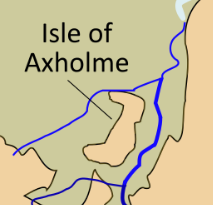Isle of Axholme


The Isle of Axholme is a geographical area in England: a part of North Lincolnshire that adjoins South Yorkshire. It is located between the towns of Scunthorpe and Gainsborough, both of which are in the traditional West Riding of Lindsey, and Doncaster (in South Yorkshire).
Description
The name Isle is given to the area since, prior to the area being drained by the Dutchman
The boundaries of the Isle of Axholme usually match with those of the ancient
Much of the northern part of the Isle has flat topography, with rich farmland used mainly to grow wheat and sugar beet. The land is particularly fertile due to its history of annual flooding from the Trent and peat soil which was created by dense ancient woodland which covered much of the Isle. Even today, in many parts of the northern Isle, petrified wood can be found at about six feet below ground; relics from this woodland, these are locally called "bog oaks".
A long-distance walking route, the "Peatlands Way", traverses the Isle.[2][3]
Etymology
Axholme means "island by
Historical descriptions
1833 description
Axholme, Isle of Area of slight elevation above flat and formerly marshy tract bounded by the Rivers Trent, Torne and Idle. Towns include Crowle, Belton, Epworth and Haxey on higher ground and Owston Ferry and West Butterwick beside the River Trent
— Bartholomew's Gazetteer of Britain compiled by Oliver Mason (John Bartholomew, 1833)
1911 description
AXHOLME, an island in the north-west part of Lincolnshire, England, lying between the rivers Trent, Idle and Don, and isolated by drainage channels connected with these rivers. It consists mainly of a plateau of slight elevation, rarely exceeding 100 ft., and comprises the parishes of Althorpe, Belton, Epworth, Haxey, Luddington, Owston and Crowle; the total area being about 47,000 acres.
— "Axholme". Encyclopædia Britannica. Vol. 3 (11th ed.). 1911. p. 68.
Land drainage history

The Isle is known for the early influence of
Road and railway
The
Governance
There was an Isle of Axholme Rural District from 1894 to 1974, which covered the entire Isle after 1936. This became part of the Boothferry district of Humberside in 1974, and since 1996 has been in the North Lincolnshire unitary authority.
Following boundary changes in 2023, the isle will be part of the new Doncaster East and the Isle of Axholme parliamentary constituency.
Notes
- ^ "Hundred of Epworth". Domesday Book. opendomesday.org. Retrieved 31 January 2022.
- ^ "Peatlands Way". www.ldwa.org.uk. Long Distance Walkers Association. Retrieved 31 January 2022.
- ^ "The Peatlands Way". thepeatlandsway.com. Retrieved 31 January 2022.
- ^ Chisholm, Hugh, ed. (1911). . Encyclopædia Britannica. Vol. 3 (11th ed.). Cambridge University Press. p. 68.
- ^ Isle of Axholme Internal Drainage Board website Archived 4 October 2011 at the Wayback Machine
References
- Fotheringham, Michael John. "The isle of Axeholme". Retrieved 27 October 2013.
- "The Isle of Axeholme". Axeholme Informer. Archived from the original on 29 October 2013. Retrieved 27 October 2013.
